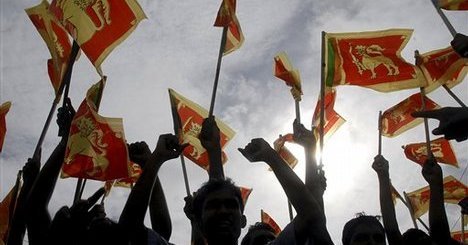With the military defeat of the Liberation Tigers of Tamil Eelan (LTTE) in mid-May 2009, their proposal of a ‘two-State solution’ for the island is probably dead forever. The idea of creating a Tamil State from the north and part of the east of Sri Lanka was unrealistic from the start as Tamils live in all parts of the country even if there are concentrations in the north and east. However, the LTTE was able to become the ‘voice’ of the Tamil population and effectively silenced all serious discussion of other avenues of structuring the State.
Now, there will be a real possibility of discussing different types of decentralization of authority. While the responsibility of finding new State structures that give confidence to all in Sri Lanka that the State is fair and works for the common good, federalist thinking from outside may play a positive role.
As there is a large Sri Lankan community in Europe, many of whom are educated Tamils, discussions with federalists in Europe could be organized. The Government of Sri Lanka, while currently in a strong nationalist phase after its military victory, nevertheless expressed a willingness to have international attention paid to the decentralization process. This process is part of Amendment 13 to the Sri Lankan Constitution though it has never been put into practice. The willingness to have international discussion of the application of the 13th Amendment was part of the final resolution of the UN Human Rights Council Special Session held in Geneva on 27 May 2009. The Ambassador of Sri Lanka played an active role in writing the resolution, indicating what was and what was not acceptable to his government.
A Special Session is the prime method that the Human Rights Council has to attract attention to a country situation and to give its resolutions added weight as only one country is considered. Normally, a session of the Human Rights Council produces 10 or more resolutions on a host of issues so that, in practice, none stand out very clearly unless there has been a good deal of debate about a particular issue. The recommendations, which we will discuss in detail, set out a framework for action by the Government of Sri Lanka, the UN humanitarian and development agencies and Non-Governmental Organizations (NGOs).
The fact that human rights issues were raised in the case of the Sri Lankan Special Session and that political guidelines concerning the decentralization of power were part of the final resolution are important milestones.
This Special Session on Sri Lanka is innovative in two respects. The first is that it was the Human Rights Council which took the lead in setting out clearly post-conflict guidelines. In the past, it has been the UN Development Programme (UNDP) that would call a post-conflict conference. The usual aim was to raise money for reconstruction and some economic development planning. At these UNDP meetings, human rights and political issues were avoided. I had participated years ago in the UNDP-sponsored conference after the change in government in Equatorial Guinea, a country under review in the then UN Commission on Human Rights. Representatives of the Centre for Human Rights — the UN Secretariat section responsible or all human rights issues — were not invited to the meeting. Despite my efforts in the hallways as an NGO representative to inform government representatives of the continuing human rights violations in Equatorial Guinea, human rights and political issues were never raised. The same was true later of a post-conflict UN fund raising conference on Mozambique, which I had attended, as the Ambassador from Mozambique had been one of my students. The terms of the peace accord that brought the civil war to an end in Mozambique should have been discussed because economic development depended in part on the terms of the peace accord being carried out. However, the whole conference turned around how much money could be raised.
Thus, the fact that human rights issues were raised in the case of the Sri Lankan Special Session and that political guidelines concerning the decentralization of power were part of the final resolution are important milestones. The UN, as an institution, works on precedent. If something has never been done, it is very difficult to get an innovation through. If something has been done once, the next time it is easier to do it. [1]
The second innovation of this Special Session was the important recognition given in the final resolution to the concept of the Responsibility to Protect. As has been said in the preparation to the UN General Assembly resolution recognizing the concept of the Responsibility to Protect “If we believe that all human beings are equally entitled to be protected from acts that shock the conscience of us all, then we must match rhetoric with reality, principle with practice. We cannot be content with reports and declarations. We must be prepared to act.” [2] There were two post-Cold War events that started the intellectual policy wheels turning. The first was the 1994 Rwanda genocide, and the second was the slaughter of Muslim men at Srebrenica, ex-Yugoslavia in 1995, hardly a year later. Neither the Rwanda genocide nor the systematic killing of prisoners of war in Srebrenica could be explained in political terms. Any political aims that the participants had could have been gained better with less killing. If one was not to limit one’s analysis to saying that the Rwandans and Serbs were ‘savages’ motivated by unknowable but primitive passions, some explanation of events had to be presented and then some avenues to prevent their recurrence was necessary.
Explanations of irrational political behaviour are difficult for policy makers. It is a slippery slope, and ‘original sin’ is not a popular explanation these days. Thus, it is easier for policy makers to discuss what to do when such conflicts start, or better, on the eve of starting.
The first calls for action came from Bernard Kouchner, who had been a French Red Cross doctor in Biafra in the late 1960s and for whom action was more important than long discussions on the fine points of international law. He had been surprised by the restrictions placed by the International Committee of the Red Cross on denouncing conditions in Biafra. Thus, he and some of his French Red Cross co-workers in Biafra created a new organization ‘Doctors without Frontiers’ which would go where they were needed if governments liked it or not. Kouchner became a highly popular figure in France and always had good relations with the media to spread his ideas. The fact that his wife is a leading television news journalist is not a handicap. Kouchner was taken into the Socialist-led French government in 1980, first for humanitarian affairs and later as Minister of Health. He started speaking of the “duty of humanitarian intervention”. The idea was taken up by NGOs and by a few international law professors, in particular Mario Bettati who was active in NGO circles. Bettati helped to give a legal foundation to Kouchner’s ideas. As there are periodical meetings of ministers of the European Union, Kouchner’s “humanitarian intervention” proposals were increasingly discussed. No other government took up the idea, but it was a difficult idea to oppose.
Kouchner’s “duty of humanitarian intervention” was progressively transformed into the Responsibility to Protect.
Kouchner’s “duty of humanitarian intervention” was progressively transformed into the Responsibility to Protect. The idea found its way to the UN Secretary-General’s High Level Panel on Threats, Challenges and Change, which then passed it on to the UN Advisory Committee on Genocide Prevention. Finally, the Responsibility to Protect was formally and unanimously embraced by the UN General Assembly meeting of heads of state at the 2005 World Summit. Many of these same heads of state have lawyers who can advise them that the Responsibility to Protect is no more binding on them than their 2000 pledge to cut world poverty in half by 2015.
There was a good deal of closed-door negotiation prior to the start of the Special Session. The UN High Commissioner for Human Rights, Navanethem Pillay, had publicly called for an independent investigation into war crimes committed by both sides, especially in the last two months which saw the last round of the civil war. She said “In no circumstances can the end justify the means. There are strong reasons to believe that both sides have grossly disregarded the fundamental principle of the defence of civilians”. The Swiss delegation, while not going as far as calling for an independent investigation, raised the issue of the violations of humanitarian law. Switzerland is particularly active on humanitarian law issues being the home of the Geneva-based International Committee of the Red Cross. The dynamic Sri Lankan Ambassador Dajan Jayatilleka was active in explaining just what was acceptable to the Sri Lankan government and setting out what he considered to be the “domestic matters” of the Sri Lankan state.
Thus, what is important in the four action points of the final resolution of the Special Session is not so much the ideas than the fact that they were agreed to by the Sri Lankan government in advance and thus serve as internationally accepted policies on which the UN has a duty to follow the progress of these policies. This is an important breakthrough.
The first important element is the recognition of the status of Internally Displaced Persons (IDPs). The status of refugees — people crossing state frontiers — is fixed by the 1948 Refugee Convention with some follow up measures. The reality of internally displaced persons is not set in a treaty and exists in international law only through UN General Assembly resolutions and the creation of the post of Representative of the UN Secretary-General on the Human Rights of Internally Displaced Persons. The current Representative, Walter Kaelin, has recently been to Sri Lanka for talks. Thus, the government of Sri Lanka recognizes the existence of IDPs and their right to safe drinking water, sanitation, food, medical and health-care services. Moreover, the resolution acknowledges the commitment of the Government of Sri Lanka to provide access as may be appropriate to international humanitarian agencies in order to ensure humanitarian assistance. “As may be appropriate” is a phrase that government hold to as it opens doors to possible limitations, but the importance must be on the word access.
The second important element is to set a time limit for resettlement. When the detention camps were first set up at the end of April 2009, some government administrators were speaking of two years before everyone would be resettled. Now there is a 6-month deadline to which the Sri Lankan government has agreed and to which it must be held.
The third important element of the resolution is the agreement to a policy of the rehabilitation and reintegration of former child soldiers. The LTTE had made wide use of child soldiers. There are real difficulties in their reintegration into society. The government of Sri Lanka has agreed to recognize this special category of people — an important step in the implementation of the rights of the child.
The fourth element is a crucial one, because it recognizes an international legitimacy in following the evolution of the political structures of Sri Lanka. This is the agreement in the UN resolution to implement the 13th Amendment to the Sri Lankan Constitution. The 13th Amendment concerns the decentralization of power and the creation of administrative councils so that political power may be closer to the people. The provisions of the 13th Amendment had never been put into practice. Thus the Sri Lankan government has promised a decentralisation of the administration and by including the item of the 13th Amendment in the UN resolution, gives UN bodies the right to follow its real implementation.
While each of these elements may seem small in contrast to the suffering caused by the civil war, they add up to a major step forward for the rule of world law.


Follow the comments: |
|
